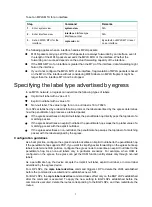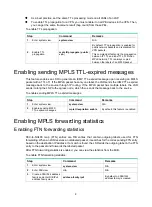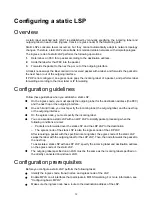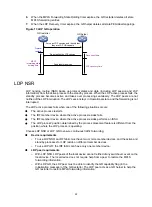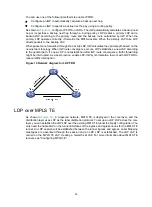
18
•
Advertisement
messages
—Create, alter, and remove FEC-label mappings, such as Label
Mapping messages used to advertise FEC-label mappings.
•
Notification
messages
—Provide advisory information and notify errors, such as Notification
messages.
LDP uses UDP to transport discovery messages for efficiency, and uses TCP to transport session,
advertisement, and notification messages for reliability.
LDP operation
LDP can operate on an IPv4 or IPv6 network, or a network where IPv4 coexists with IPv6. LDP
operates similarly on IPv4 and IPv6 networks.
LDP operates in the following phases:
Discovering and maintaining LDP peers
LDP discovers peers in the following ways:
•
Basic
Discovery
—Discovers directly connected LSRs.
{
On an IPv4 network, an LSR sends IPv4 Link Hello messages to multicast address
224.0.0.2. All directly connected LSRs can discover the LSR and establish an IPv4 Link
Hello adjacency.
{
On an IPv6 network, an LSR sends IPv6 Link Hello messages to FF02:0:0:0:0:0:0:2. All
directly connected LSRs can discover the LSR and establish an IPv6 Link Hello adjacency.
{
On a network where IPv4 and IPv6 coexist, an LSR sends both IPv4 and IPv6 Link Hello
messages to each directly connected LSR and keeps both the IPv4 and IPv6 Link Hello
adjacencies with a neighbor.
•
Extended
Discovery
—Sends LDP IPv4 Targeted Hello messages to an IPv4 address or LDP
IPv6 Targeted Hello messages to an IPv6 address. The destination LSR can discover the LSR
and establish a hello adjacency. This mechanism is typically used in LDP session protection,
LDP over MPLS TE, MPLS L2VPN, and VPLS. For more information about MPLS L2VPN and
VPLS, see "Configuring MPLS L2VPN," and "Configuring VPLS."
LDP can establish two hello adjacencies with a directly connected neighbor through both discovery
mechanisms. It sends Hello messages at the hello interval to maintain a hello adjacency. If LDP
receives no Hello message from a hello adjacency before the hello hold timer expires, it removes the
hello adjacency.
Establishing and maintaining LDP sessions
LDP establishes a session to a peer in the following steps:
1.
Establishes a TCP connection to the neighbor.
On a network where IPv4 and IPv6 coexist, LDP establishes an IPv6 TCP connection. If LDP
fails to establish the IPv6 TCP connection, LDP tries to establish an IPv4 TCP connection.
2.
Negotiates session parameters such as LDP version, label distribution method, and Keepalive
timer, and establishes an LDP session to the neighbor if the negotiation succeeds.
After a session is established, LDP sends LDP PDUs (an LDP PDU carries one or more LDP
messages) to maintain the session. If no information is exchanged between the LDP peers within the
Keepalive interval, LDP sends Keepalive messages at the Keepalive interval to maintain the session.
If LDP receives no LDP PDU from a neighbor before the keepalive hold timer expires, or the last hello
adjacency with the neighbor is removed, LDP terminates the session.
LDP can also send a Shutdown message to a neighbor to terminate the LDP session.
An LSR can establish only one LDP session to a neighbor. The session can be used to exchange
IPv4 and IPv6 FEC-label mappings at the same time.




